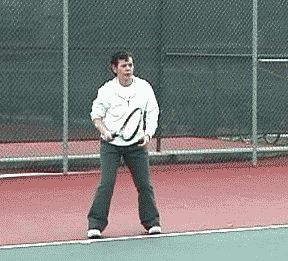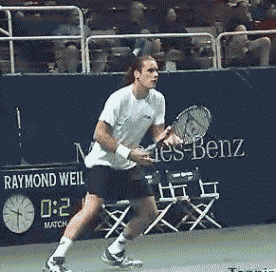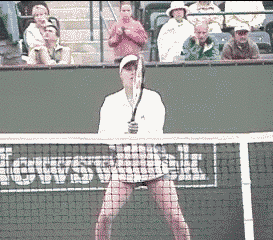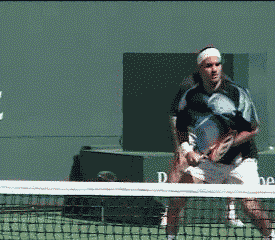|
TennisOne Lessons


Be Your Own Coach with These Simplicity Checkpoints!
Dave Kensler - Peter Burwash International (PBI)
Tennis is a game of emergencies! The goal of your opponent is to make your life miserable and put you in as many uncomfortable situations as possible. You are trying to do likewise.
That is the one key reason why I don't use the following phrases when teaching: "Turn sideways; take your racquet back; watch the ball; step into the shot and follow through." If you have the time to do all of those with every stroke; then you are playing someone who is not challenging you! So, how can you tell if you are being challenged? Your opponent is forcing you to hit at least 50% of your shots while you're moving! They are not allowing you the opportunity to "set up" each time to hit a shot.
 Form alone does not win tennis matches! Sometimes the player with the goofy looking shots wins. And this happens on every level.
Form alone does not win tennis matches! Sometimes the player with the goofy looking shots wins. And this happens on every level. |
The bigger problem which arises with those phrases is they don't help you correct your mistakes i.e. Even if you do that sequence to perfection each time, the ball will always go into the net if the racquet face is closed at contact! Yet many players mistakenly focus on those thoughts when competing with the expectation that a correction in their form will help them play better or even win.
Form does not necessarily win tennis matches! We have all seen the player who has picture perfect strokes but loses most of the time; or the player with the goofy looking shots win many of their matches.
This is, however, all relative. As players progress, goofy looking shots defy the improvement process and only allow players who use them to succeed against those who are not profiecent enough to expose the weaknesses of such shots. That said, the statement still holds true, at all levels, the player with the prettier strokes will not necessarily win the match. After all, Brad Gilbert did quite well for himself 'Winning Ugly.'
In my last article I detailed how using your opposite hand will help give you better racquet awareness and control in addition to allowing you to correct your hitting errors. In this article I will offer "Simplicity Checkpoints" which you can apply to your strokes in an instant, whether during practice or competition. In turn, these checkpoints will help you "recover" a stroke which seems to have suddenly "disappeared!"
I believe learning how to be your own coach whether in practice or competition, may be the most important "technique" to have as a tennis player! Your teaching pro, coach, team members, and friends will not always be available to help. To be successful in tennis, you need to learn to coach yourself. The information I share in these articles, like using your opposite hand and simplicity checkpoints, offer you the opportunity to become your own coach!
Following are some checkpoints for the most common shots used: Ground strokes, volley, and serve.
Groundstrokes
- Think "fast feet, slow arm" when you are hitting wild shots. Think of the arm in slow motion during the swing. Many times players swing as fast as they are moving, yet watch the pros and how well they control their racquet despite being in an emergency situation with their feet and body!
-

Pros lengthen the contact area and reduce "semi-circle" swings by swing out toward the target before the wrap. |
To eliminate a slapping motion, squeeze the last three fingers to firm up the wrist. Most players squeeze too hard with their thumb and index fingers. Every once in a while I will give a tennis lesson to a doctor who is a hand surgeon and they always confirm to me the strength of your wrist is in your LAST 3 fingers and not the thumb and index finger!
- At the end of your stroke, "freeze" the racquet to check your finish. Is it wrapped around your body? For underspin the racquet face should be open. For topspin the racquet should be "on edge" with the tip pointing upwards.
- Visualize hitting through four balls to lengthen the contact area and reduce "semi-circle" swings.
- For the forehand think, "palm forward" and for the backhand (one-handed), "knuckles forward" to again, help with your contact area.
Volley
- Think "catch." This will eliminate unnecessary punching motions or big swings. If someone tosses you a ball to catch, you don't swing or punch your entire arm at a fast pace! Remember, most of the time when you are going to hit a volley you are 5-10 feet from the net. You don't have to swing for the ball to go over the net.
-

Martina Hingis uses a minimal swing on the backhand volley. |
Keep the racquet head and wrist together. This prevents volleying with a slapping motion.
- On the forehand volley keep a bent hitting arm i.e. Your arm should go "bent to bent" as you hit; not "bent to straight." On your volley, the racquet head should move about 10 inches at most. Any more and you are swinging or punching. As you increase the length of your swing the chance for an error also increases.
Serve
- Make sure your wrist is relaxed. If your serves are going long then think "snap down" more with the wrist; if your serves are hitting the net then think "snap up" with the wrist. A relaxed wrist can "save" your serve regardless of the conditions i.e. wind, sun, lights, nervousness, tightness, bad ball toss, fatigue and so on.
Note: For the ground strokes, squeeze the last three fingers in order to firm up the wrist you; for the serve do the opposite! Gently wrap the your thumb and index finger around the grip and let the last three fingers relax.
- As much a reminder as a checkpoint, you are only as good as your second serve! If this is a weak part of your game, then work on the technical aspect of it. Learn to hit topspin, slice, and flat serves. To create pressure in practice, play a set or match with only one serve allowed instead of two!
Overall Checkpoints
- Make sure your opposite hand is being used to support and guide the racquet in addition to helping correct mistakes.
-

Learn to recognize an offensive opportunity like when the point of contact is above the net band. |
Don't make the same mistake two times in a row! If you serve two balls in a row long; then you are not using your wrist (See above) to make the necessary corrections. If you hit a forehand ground stroke two times in a row into the net; then you are not using your opposite hand to correct the racquet angle.
- Use the white net band to help you determine offense and defense. If your point of contact is below the net band, this is more of a defensive hitting situation because the ball first has to rise to go over the net. If the point of contact is above the net band this is more offensive. Many points are lost by trying to hit offensively while the ball is in a defensive position (Below the net band).
- Are you playing the big points well? Often I will ask my students the question, "How many game points are played on the deuce-court and how many are played on the ad-court?" Less than 10% can answer correctly within 15 seconds! Often these are people who have been playing for years!
In case you are wondering. The only game points played on the deuce court in traditional scoring (No-Ad can be different) is 40-15 or 15-40. All other game points are played on the ad court. Also, the 30-15 /15-30 point, arguably the most important point in the middle of a game, is an ad court point.
Most of all, not everyone plays well all of the time. Learn to enjoy the challenge of trying to win when you are not playing well!
Use these checkpoints and you may find success when you may least expect it - In the middle of a match in which you not playing well! Learn to be your own coach
Your comments are welcome. Let us know what you think about Dave Kensler's article by emailing us here at TennisOne.

Dave Kensler has been teaching tennis for 23 years with Peter Burwash International(PBI).
PBI contracts with resorts, hotels and clubs all over the world to direct tennis programs. The company presently has professionals working at 62 facilities in North America, Europe, Asia, Middle East, Caribbean, Pacific and Indian Ocean. During its 30 years in business, PBI tennis professionals have taught tennis in over 135 countries. For more information visit: www.pbitennis.com.
|
|




